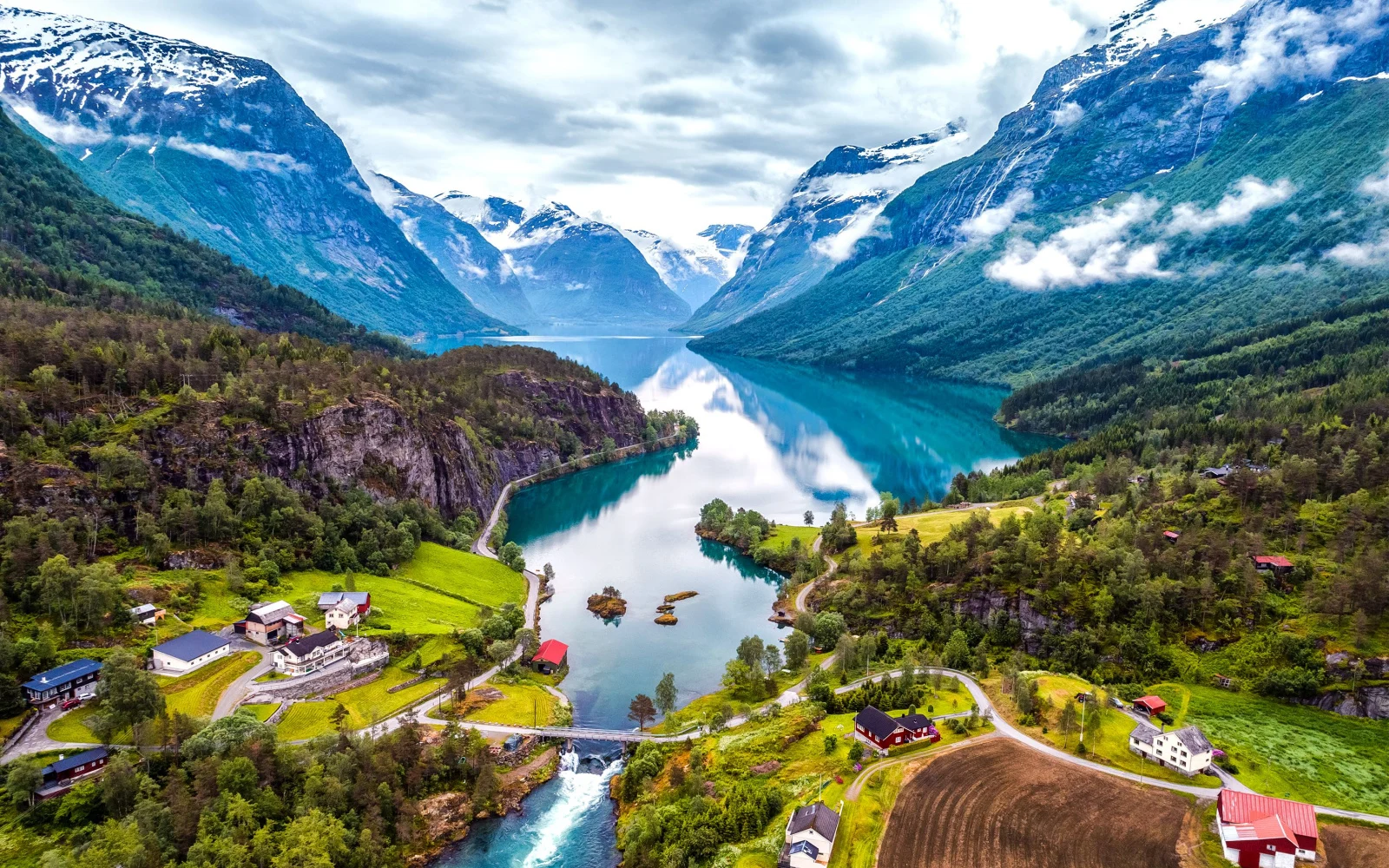Scandinavia is one of the safest regions in the world to visit. With low crime rates and friendly locals, you can relax and enjoy your trip without having to worry about your safety. But that’s not a blanket statement; learn why below.
Is Scandinavia Safe to Visit in 2024?
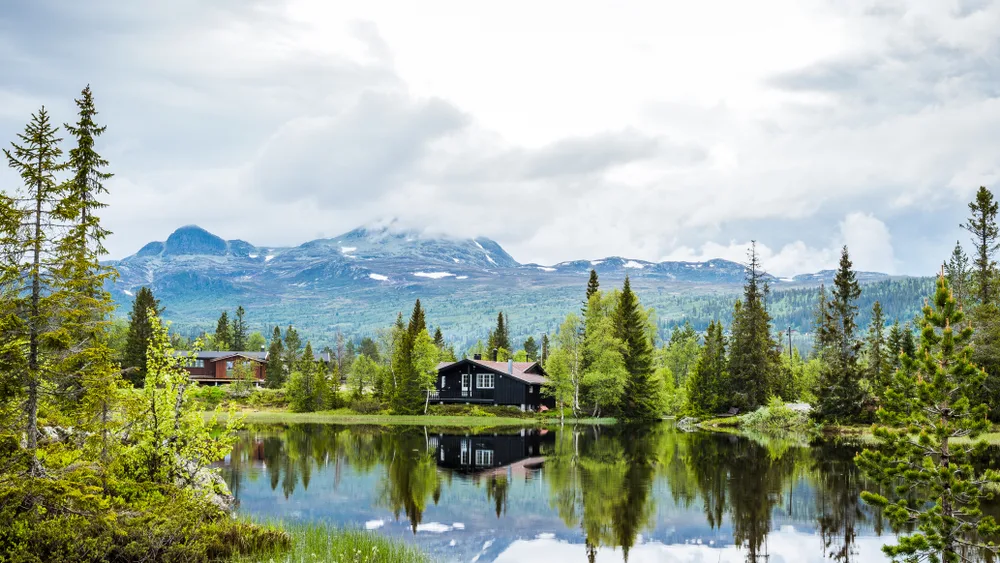
Dreamnord/Shutterstock
Yes, Scandinavia is one of the safest regions in the world to visit. The countries that makeup Scandinavia are safe and have low crime rates.
While negative incidents such as terrorist attacks and extreme weather can happen, they are few and far between.
Scandinavia is a region that is made up of multiple countries, although definitions disagree on which ones make up Scandinavia. Everyone agrees that Scandinavia includes Sweden, Norway, and Denmark, but some people include Iceland and Finland.
The region also includes smaller semi-autonomous areas such as the Faroe Islands. To give you a complete picture of the region, we will include information about all these regions.
It is easy to generalize about safety in Scandinavia because these countries are similar culturally, politically, and economically. They also have similar safety ratings. Namely, the Scandinavian countries routinely top lists of the world’s safest places.
According to the Global Peace Index, 3 of the 15 safest countries in the world are in the wider Scandinavia region (Finland, Denmark, and Iceland). The remaining countries, Sweden and Norway, are also considered to be very safe.
Travel advisories for the countries in this region also tend to assess countries here as being fairly safe. For example, the United States issues a Level One travel advisory for the Scandinavian countries of Iceland, Norway, and Finland.
The U.S. issues slightly elevated Level Two travel advisories for some parts of Scandinavia, such as Sweden and Denmark, but even there the risk levels are fairly low.
The countries share some shared challenges. Common problems include:
- Theft
- Fraud
- Gang violence (only in major cities)
- Terrorism
These problems are not evenly distributed throughout Scandinavia. Generally, they tend to be concentrated in big cities in Sweden, Denmark, and sometimes Norway. Even there, the rate of these problems is fairly low.
It is just a good idea to be cautious just in case and prepare for things that might happen.
One thing the Scandinavian countries have in common is their climate and landscape. These countries are far north, which means that their winters are cold and extreme.
Winter is a magical time to visit due to the snow and features such as the Northern Lights, but make sure that you are prepared before visiting. Wear warm clothing, pack layers, and be especially careful if you are going into nature in the winter.
Many visitors come to Scandinavia with the goal of enjoying adventure travel, from Arctic cruises to trekking and skiing.
The Australian government includes safety advice for adventure tourism in Scandinavia in its travel advisory for regional countries such as Norway.
When exploring nature, good practices include:
- Always checking the weather forecast and alerts — and not thinking you can “beat the storm.”
- Picking trails and activities that are within your physical activities.
- Going with a reputable guide or tour group, especially for remote destinations.
- Sticking to marked paths for hiking and skiing.
- Buying good travel insurance.
- Always sharing your location and itinerary with someone not on your trip so they can alert the authorities if you don’t respond in time.
Good preparation can usually prevent negative incidents. Plus, Scandinavian countries have expert search-and-rescue teams that help travelers in case any danger does happen (although the cost of evacuation can be pricey if you don’t have travel insurance).
Crime in Scandinavia
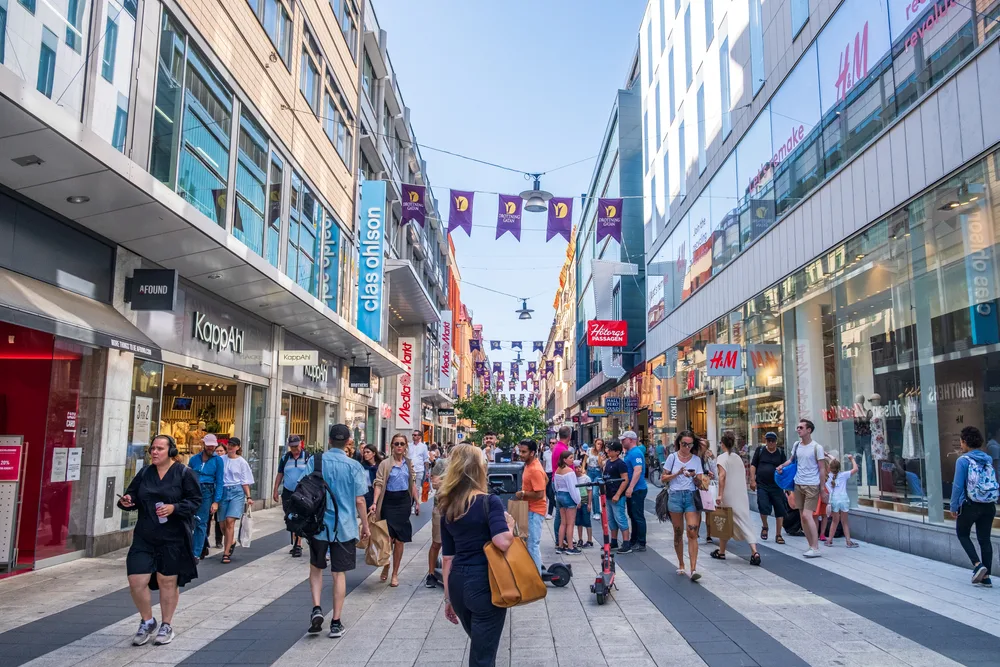
Stockholm, Sweden – July 5 2021: Drottninggatan during a busy summer day in Stockholm, Sweden. Shopping avenue, popular tourist destination./Zuzana Habekova/Shutterstock
When most people travel abroad, they worry about being the victim of a crime in a foreign country. The good news is that crime is not that major a problem in Scandinavia.
Although crime is present, the crime rates in most Scandinavian countries are low.
For example, Sweden’s crime rate is 13,803 incidents per 100,000 people. It has been decreasing for the last several years. The vast majority of crime incidents in Sweden are petty offenses such as traffic violations or vandalism.
The violent crime rate is one of the lowest in the world, at just 1.08 incidents per 100,000 people. Denmark has a similar crime rate. The overall crime rate is 9,500 incidents per 100,000 people.
Property crimes and other petty offenses make up the biggest portion of crime in Denmark. Like Sweden, Denmark has a low violent crime rate. For example, the homicide rate is 0.80 incidents per 100,000 people.
Norway, Iceland, and Finland have even lower homicide rates than the two most populous Scandinavian countries.
Norway’s crime rate is less than 52 incidents per 1,000 people. In Finland, the crime rate is 85.54 incidents per 1,000 people, and the most common incidents are petty crimes such as traffic violations and fraud.
Iceland has just 2,127.4 crimes per 10,000 people and about 2 homicides a year, making it one of the safest countries in Scandinavia and the world.
These crime statistics show that although there are criminal incidents in Scandinavia, the crime rates are some of the lowest in the world. You should still take some common sense precautions, but crime really isn’t something that you have to worry about when you visit Scandinavia.
Theft
The most common crimes in Scandinavia are petty offenses, such as pickpocketing. The rate of pickpocketing in Scandinavian cities is fairly low compared to other places in Europe, such as Barcelona, but it is still a good idea to be on your guard.
The Canadian government warns about the risk of pickpocketing in its travel advisories for several Scandinavian countries, including Norway.
Thieves operate around popular tourist sites, in hotel lobbies, in train stations and other intercity or international transportation hubs, and on public transportation.
The precautions you should take to protect yourself from theft are the same, regardless of which Scandinavian country you are visiting.
Make sure that you don’t leave your possessions unattended or somewhere where they are easy to snatch, such as on the floor in a train station or on your patio table when dining in a crowded area.
Put your phone, wallet, and ID in a front pocket or zipped bag compartment when walking through crowded areas. Maintain basic situational awareness as you move around Scandinavia.
If someone is brushing up against you, keep a firm grasp on your valuables. Be careful of people approaching you in the street as they may be scammers.
Although theft can occur in Scandinavia, the rate of theft is fairly low. Basic common sense is usually enough to protect yourself from theft while visiting the region, and you don’t need to let fear of theft ruin your trip.
Terrorism
Unfortunately, safe Scandinavia also has an elevated risk of terrorism. Over the past several years, there have been a few high-profile terrorist incidents in the region.
In 2011, Norway suffered the Utoya massacre, when a far-right fascist terrorist massacred over 70 people, most of them teenagers. Sweden has also experienced terrorist attacks recently, such as the 2021 stabbing rampage in Vetlanda.
Several Scandinavian countries have elevated terrorist attack rates. Sweden raised the terrorist alert level to Level 4, which is high, in part due to a spate of Quran burnings. Norway also reports elevated terrorist alert rates.
The terrorist alert rate in Denmark is also at a Level 4, which is classified as serious. In Finland, the terrorist alert rate is much lower, at Level 2. It is moderate in Iceland as well.
When you realize that many countries such as Canada warn about terrorism in their travel advisories for Scandinavian countries including Sweden, you may be too worried to visit.
However, countries have to warn you about the risk of something happening. Just because there is a risk, does not mean that it will affect you.
You can be aware of this risk, but don’t let the risk of terrorism change your travel plans. Just monitor government alerts and the news before your trip, and only change your plans if the government (your home government or that of your destination country) advises you to do so.
You can be somewhat vigilant in public places, but you don’t have to be overly cautious.
Terrorism is random by definition and can occur anywhere and at any time — even in your hometown. Don’t let the fear ruin your trip but have some awareness about the risk.
Avoiding Bad Areas
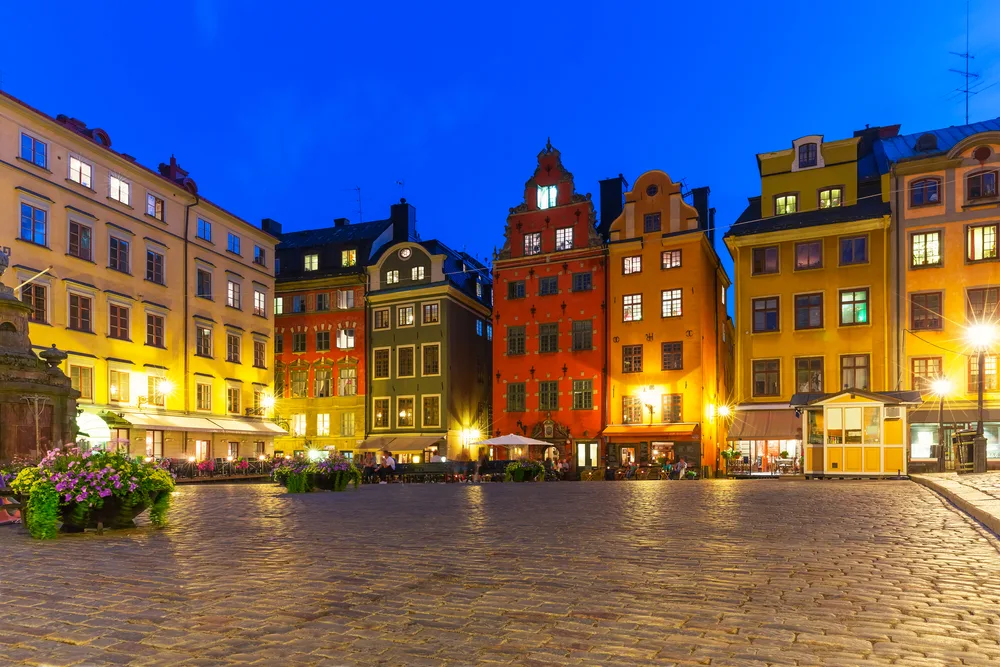
Oleksiy Mark/Shutterstock
Most of Scandinavia is very safe. However, the biggest cities have some neighborhoods that are best avoided, or at least where you should exercise caution.
In Denmark, avoid:
- Christiania (only after dark)
- Norrebro in Copenhagen
- Husum in Copenhagen
- Amager Island in Copenhagen
- Gellerupparken in Aarhus
In Sweden, avoid:
- Biskopsgarden in Gothenburg
- Bergsjon in Gothenburg
- Rosengard in Malmo
- Södra Sofielund in Malmo
- Husby in Stockholm
- Ronna in Stockholm
- Gottsunda in Uppsala
Most cities in Norway, Finland, and Iceland are fairly safe.
Things to Consider

Denis Belitsky/Shutterstock
Here are a few additional tips when visiting Scandinavia:
- Take additional care when visiting the Arctic regions. Search and rescue efforts are harder here due to the remote nature and extreme weather. Only venture off the path with an experienced guide.
- Make sure that you have the right equipment. Activities such as glacier climbing are risky unless you have the right gear and the right know-how.
- Some cities in Scandinavia have problems with gang violence. However, this is confined to certain inner-city neighborhoods. Make sure that you trust your gut and avoid areas that feel unsafe, and you shouldn’t run into this problem.
- Register for emergency alerts when possible. This is especially important if you are planning on some adventure tourism excursions. Some countries also have alert systems where you can register your itinerary and easily call for rescue when hiking.
Frequently Asked Questions
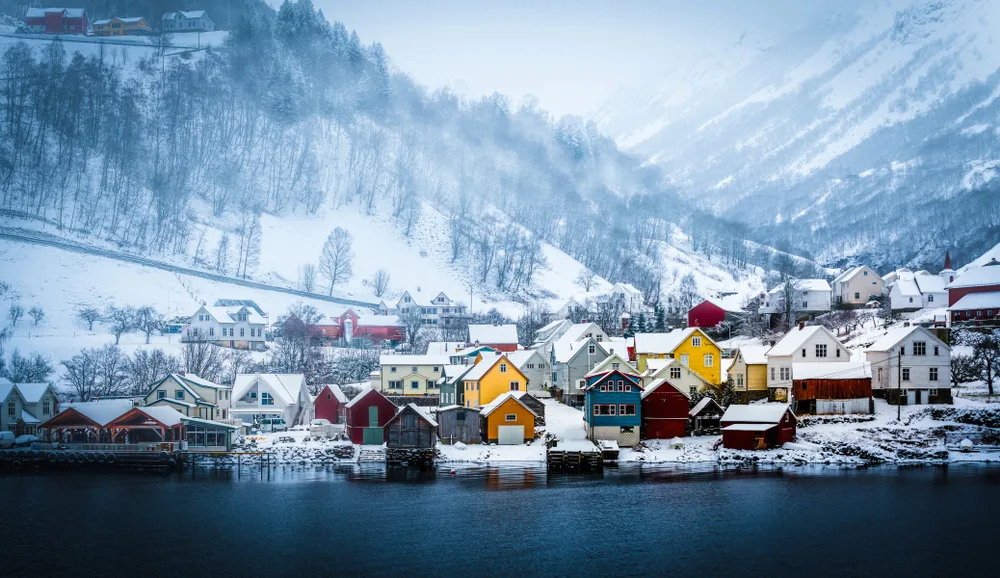
In Green/Shutterstock
Here are a few common questions people have asked before visiting Scandinavia before:
Is it safe to go to Scandinavia?
Yes, it is very safe to go to Scandinavia. The crime rate is very low, even though some crime occurs in the major cities.
Which Scandinavian countries are the safest?
The safest Scandinavian countries are probably Norway and Iceland. However, all the Scandinavian countries routinely top lists of the safest countries in the world.
Is Scandinavia safe to travel alone?
Scandinavia is very safe, even for solo travelers. However, avoid going alone when hiking or exploring remote natural areas. Try to go with a buddy or a guide, and always let someone who is not on your trip know where you are.
Is Sweden safe to visit now?
Sweden is safe to visit now. Although it has the highest terrorist alert level it has had in years, the authorities are working hard to keep everyone safe.
Is Sweden or Norway safer?
Norway is safer because it has a much lower crime rate and a much lower violent crime rate. In fact, Norway is one of the safest countries in the world.
Over to You — Book Your Trip to Scandinavia Today!
Scandinavia is one of the safest regions in the world to visit. It has a low crime rate and the countries that make up the region are well-governed and safe.
So, with so much to see and do, what are you waiting for — book your trip today and experience for yourself all that Scandinavia has to offer. Happy travels!



